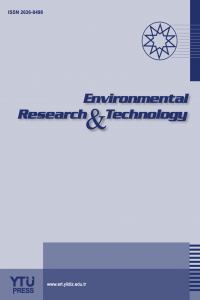CO2 Capture Analysis of Tobacco Biochar-AlCl3 Composite
CO2 Capture Analysis of Tobacco Biochar-AlCl3 Composite
In this study, the performance of tobacco biochar-AlCl3 composite for CO2 capture was investigated. Biochar-AlCl3 composites were prepared at different blend ratios (10:0.4; 10:2; 10:4, wt./wt.) and used for CO2 capture experiments to determine the optimal Al metal content at which CO2 adsorption was highest. Biochar composites were produced through slow pyrolysis under inert nitrogen atmosphere in a fixed bed reactor at 600oC for 3h. Properties of biochar-metal composites and raw biochar samples were characterized with SEM-EDS, XRD and FTIR analysis. CO2 experiments were conducted in TGA under N2 atmosphere with a flow rate of 50 ml/min at 25°C. The maximum CO2 adsorption was observed as 59.97 mg/g for biochar: AlCl3 composite at a ratio of 10:2. Finally, results of study showed that biochar-AlCl3 composites have great potential as a CO2 capture material due to its low-cost, sustainability and CO2 capture capacity.
Keywords:
Biochar composite, CO2 capture, AlCl3,
___
- [1] J. Pires, A. Ferraz, F. Martins ve M. Simões, «Carbon dioxide capture from flue gases using microalgae: Engineering aspects,» Renewable and Sustainable Energy Reviews, no. 16, p. 3043– 3053, 2012.
- [2] Y. Pan, X.-X. Zhang, Z. Zhang, X.-S. Tong, C.-Z. Jia, B. Liu, C.-Y. Sun, L.-Y. Yang ve G.-J. Chen, «Large-scale synthesis of ZIF-67 and highly efficient carbon capture using a ZIF-67/glycol-2-methylimidazole slurry,» Chemical Engineering Science, no. 137, p. 504–514, 2015.
- [3] Y.-F. Huang, P.-T. Chiueh, C.-H. Shih, S.-L. Lo, L. Sun, Y. Zhong ve C. Qiu , «Microwave pyrolysis of rice straw to produce biochar as an adsorbent for CO2 capture,» Energy, pp. 75-82, 2015.
- [4] A. E. Creamer, B. Gao ve M. Zhang, «Carbon dioxide capture using biochar produced from sugarcane bagasse and hickory wood,» Chemical Engineering Journal, no. 249, p. 174–179, 2014.
- [5] J. Blamey, M. Al-Jeboori, V. Manovic, P. S. Fennell ve E. Anthony, «CO2 capture by calcium aluminate pellets in a small fluidized bed,» Fuel Processing Technology, p. 100–106, 2016.
- [6] S. Wang, B. Gao, A. R. Zimmerman, Y. Li, L. Ma, W. G. Harris ve K. W. Migliaccio, «Removal of arsenic by magnetic biochar prepared from pinewood and natural hematite,» Bioresource Technology, no. 175, pp. 391-395, 2015.
- [7] Y. Yao, B. Gao, J. Fang, H. Chen, Y. Zhou, A. E. Creamer, Y. Sun ve L. Yang, «Characterization and environmental applications of clay–biochar composites,» Chemical Engineering Journal, no. 242, p. 136–143, 2014.
- [8] M. S. Shafeeyan, W. M. A. W. Daud, A. Houshmand ve A. Arami-Niya, «Ammonia modification of activated carbon to enhance carbon dioxide adsorption: Effect of pre-oxidation,» Applied Surface Science, no. 257, p. 3936–3942, 2011.
- [9] J. Novak, . W. Busscher, D. Watts, D. Laird, M. Ahmedna ve M. Niandou, «Short-term CO2 mineralization after additions of biochar and switchgrass to a Typic Kandiudult,» Geoderma, no. 154, p. 281–288, 2010.
- [10] D. Özçimen ve F. Karaosmanoğlu, «Production and characterization of bio-oil and biochar from rapeseed cake,» Renewable Energy, no. 29, pp. 779-787, 2004.
- [11] H. G. Karge, «Verified Syntheses of Zeolitic Materials,» Characterization by IR spectroscopy, 1992.
- [12] M. Bhagiyalakshmi, P. Hemalatha, M. Ganesh, P. M. Mei ve H. T. Jang, «A direct synthesis of mesoporous carbon supported MgO sorbent for CO2 capture,» Fuel, no. 90, p. 1662–1667, 2011.
- Yayın Aralığı: Yılda 4 Sayı
- Başlangıç: 2018
- Yayıncı: Yıldız Teknik Üniversitesi
